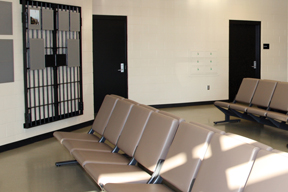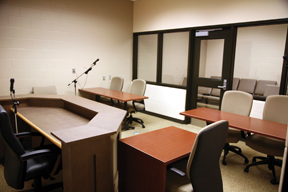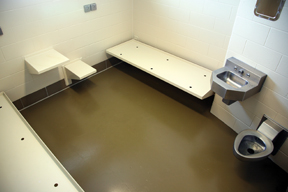Clean Slate

Project Data
Facility Name: Mercer County Detention Facility
Facility Type: County Jail
Construction Budget: $12 Million
Number of Beds: 110 Beds
Area: 54,000 square feet
Start Date: June 2008
Completion Date: December 2009
Project Team
Owner/Operator: Mercer County, Ohio
Owner Representative: Mercer County Sheriff’s Department
Architectural Firm: Shremshock Architects Inc.
General Contractor: Peterson Construction Co.
Engineering Firm: Design Engineers & Consulting Associates
Detention Equipment Contractor: Pauly Jail Building Co.
Security Electronics Contractor: Stanley Convergent Security Solutions
Product Data
Video Surveillance: Genetec Omnicast IP-based system
Intercom/Communications Systems: Integrator.com
Access Control System: Schlage Recognition Systems Biometric
Jail Management System: Emergitech Inc.
Security Screening/Video Visitation Systems: Integrator.com
Security Cell Doors/Locks: Habersham Metal Products; Brinks
Security Glazing/Windows/Skylights: North American Specialty Glass; Habersham
Detention Accessories/Furniture: Modern Detention Equipment
Mechanical Systems: Mestek RBI; Tekmar
HVAC System: McQuay International
Plumbing System: Bradley Corp.
Lighting Controls/Fixtures: Kenall Manufacturing Co.
Fire Suppression System: Fenwal Protection Systems; Viking Group
Smoke Detection System: Notifier
Security Ceilings Systems: Trussbilt
Refrigeration Equipment: American Panel Corp.
Laundry Equipment: Pellerin Milnor; Huebsch


After decades of talk about replacing the old county jail in downtown Celina, Ohio, and a sales tax increase that voters approved in late 2007, Mercer County can finally consign its aging 1939 facility to the annals of jailhouse antiquity.
The new $12 million, 110-bed Mercer County Detention Center delivers significantly more inmate housing space than the existing 71-year-old jail, which was designed to house 24 inmates and was severely overcrowded.
In fact, in the decades since its construction, the rated capacity of the existing Prohibition-era jailhouse, which also lacked the sight lines and other safety and security elements associated with modern jails, was reduced to 15 beds to comply with evolving industry standards on housing conditions.
“The original facility was in gross violation of the minimum standards for jails in Ohio,” says Vic Williamson, senior project manager for Shremshock Architects Inc. The local architecture and engineering firm, based in Westerville, provided full design services on the project.
Clean Slate
In contrast to the existing facility, which also failed to comply with federally mandated ADA standards, the 54,000-square-foot replacement facility incorporates inmate housing for male and female inmates across minimum-, medium- and maximum-security classifications, jail support space and administrative facilities.
Eighteen of the new jail’s 110 beds are dedicated to housing female inmates. However, the facility can house up to 42 females without violating standards.
The multifunction center, which was sited to optimize law enforcement, detention and judicial operations through co-occupancy and building adjacencies, also houses the offices of the Sheriff’s Department and the county’s 911 dispatch and communications operations.
“It was in the best interest of the citizens and taxpayers of Mercer County to alleviate the almost unconstitutional confinement conditions of the original facility and replace it with a new detention facility,” Williamson says.
In contrast to the cramped and aging conditions in the existing jail, the new facility also features a small courtroom and judges chambers to facilitate initial appearances and hearings as needed.
“We were experiencing waiting lists of 20 to 30 people,” says Mercer County Sheriff Jeff Grey. “Judges would actually sentence people and have them call to schedule their incarceration.”
The Sheriff expects the jail’s average daily population to increase to 60 to 70 inmates by the end of the year. The additional bed space will afford judges more flexibility in sentencing and allow them to impose custodial sentences immediately.

Beyond Repair
The old jailhouse, which is situated on a prime tract of downtown real estate, is scheduled to be raised this year.
“I want to have a member of our local historical society come through the building and identify those items that may have historical value so we can keep a piece of history for future generations,” Grey says.
Over the years, incremental reductions in rated capacity, and consequent worsening of overcrowding, at the existing jail were compounded by the steady growth in the region’s general population and the associated substantial increase in felony and misdemeanor cases and custodial sentences.
“The building was simply locking people in a cage,” Grey says. “The ability to provide rehabilitation programs was minimal, although the punishment component certainly was there.”
And therein lay Sheriff Grey’s greatest challenge: the public’s perspective and understanding of the department’s multilayered mission and getting the community to buy-in and support construction of a modern jail that would comply with standards and effectively support both incarceration and re-entry.
“They forget that eventually we will release them back into society, so it is important that we at least attempt to teach them life skills,” Grey says.
The improvements at the new are significant. The new facility is operated with direct-supervision and state-of-the technologies, such as centralized video surveillance, video visitation and video arraignment capabilities, were installed.
“Too many people in the public forget that each person in jail is someone’s child, parent, brother, sister,” Grey says. “The public perception is ‘lock them up.’”
Change is Good
After finishing the needs assessment analysis of the proposed development in November 2005, the project team completed the schematic design phase 12 months later.
During this period, stakeholders worked to develop a community outreach program, which garnered the necessary public approval to move the project forward into the construction documents phase.
“The biggest obstacle was the schedule,” says Glenn Renner, project manager at Peterson Construction Co. of Wapakoneta, Ohio, which acted as the general contractor on the project. “It didn’t give us much time to obtain enclosure.
“We had to work on concrete beams and decks through the winter to try to maintain the overall schedule with winter protection and temporary heat,” Renner says.
Construction began in June 2008 and was completed on time in December 2009.
As is often the case on local jail projects such as the Mercer detention facility, even more so in the current economic and fiscal climate, the biggest challenge encountered team by the design team was the development of a facility that would exert minimal impact on the county’s current annual operating costs.
This challenge was met and overcome using a range of strategies, including the elimination of costly inmate movement activities, the incorporation of clean site lines and a direct-supervision inmate management model, and the integration of energy-efficient infrastructure and modern technologies.
Although not designed with LEED certification in mind, the project team infused sustainable design and construction techniques throughout all phases of the project, incorporating energy-efficient building systems to generate additional performance efficiencies, lifecycle cost savings and carbon-footprint reductions.
“Although the holding capacity of the new center is 600 percent greater than the original jail, the annual operating cost for the new facility is not expected to be significantly greater than the current jail’s operating costs,” Williamson says.

Inside the Fence
The layout situates outdoor recreation in the same circulation corridor as the housing corridor, with inmate programming space located adjacent to the housing units, in order to improve staff and inmate safety and security, and reduce staffing costs associated with outmoded inmate movement and management models.
Officers at the inmate booking counter can readily view inmate/officer movement in the vehicular sally port, through the intake process, and into the housing unit. Similarly, officers stationed in the central control room can view inmate movement and activity within each housing pod.
More than 75 cameras monitor access and circulation throughout the facility to further mitigate on-going operational costs.
“Inmate visitation is scheduled online and may eventually interface with inmate management software,” Williamson says.
Video and intercom capabilities, and lighting, water, television and telephone systems are controlled with a user-friendly touch-screen control system, which is fully backed-up and operations-ready from a remote location.
Full-spectrum, day-night surveillance cameras monitor perimeter areas and building exteriors, while visitors are screened for contraband using scanning units at a secure access point in the public lobby.
Minimizing maintenance costs and maximizing safety — particularly for non-corrections staff in medical and programming — were paramount to the project team’s remit.
“Inmate hygiene areas were finished with ceramic tile floors, special glazed masonry walls and stainless steel ceilings, all of which require no maintenance,” Williamson says.
Special paint color schemes were selected to conceal marks and scratches caused by staff and inmate use and to blend with blemishes caused by general wear common to jail facilities.
“The detention area includes a special glazed-masonry base to reduce maintenance and enhance security, while active doors are equipped with stainless steel plates to protect against cart, maintenance and inmate abuse,” Williamson says.
In striving to minimize the facility’s operational costs throughout its lifecycle, the project team planned for future expansions in bed capacity by incorporating detention support services with a capacity that exceeds current populations demands.
“With a capability to double its holding capacity without compromising either efficiency or ability to operate with minimal staff, future expansion space maintains an equal relationship to the inmate support services and administration functions as does the original design,” Williamson says.
Lisa Kopochinski is a freelance writer and editor. Visit wwwlisakcommunications.net
